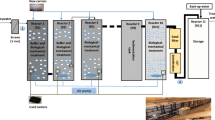Abstract
An aerated submerged biofilm (ASBF) pilot plant has been developed. The present study optimized an inexpensive method of enhanced wastewater treatment. Over a period of three and one half months, a total of 11 batch runs were performed. By the fourth run, the biofilm had matured to the point that it consumed all the ammonia in 40 hours. The investigation aimed to present mathematical models for describing the dynamic behaviors of the dissolved organic matter removal and nitrification in the Aerated Submerged Biofilm (ASBF) for a batch reactor. Based on the experimental data from the batch system of the ASBF pilot plant, mathematical models were developed to predict dissloved organic matter and ammonia nitrogen removal rates as a function of heterotrophic and autotrophic bacteria populations, dissolved organic matter concentrations, ammonia nitrogen concentrations, dissolved oxygen concentrations, and temperature. The mathematical models for dissolved organic matter and ammonia nitrogen removal in ASBF include two differential equations reflecting heterotrophic and autotrophic bacteria populations, and a number of kinetic parameters. Consequently, the results provide a better insight into the dynamic behaviors of heterotrophic and autotrophic biofilm growth and their practical application to wastewater for dissolved organic matter and ammonia nitrogen removal process.
Similar content being viewed by others
References
D. Barnes and P. J. Bliss, Biological control of nitrogen in wastewater treatment, E. & F. N. Spon Ltd. (1983).
D. V. Vayenas and G. Lyberatos, Wat. Res., 28, 1275 (1994).
Y. Argaman, G. Papkov, A. Ostfeld and D. Rubin, J. Envir. Engr., 125, 608 (1999).
R. S. Bernardes, H. Spanjers and A. Klapwijk, Bioresource Technology, 67, 177 (1999).
G. Cao, Q. Zhao, X. Sun and T. Zhang, Enzyme and Microbial Technology, 30, 49 (2002).
D. Sen, C. W. Randall, R. R. Copithorn and T. J. Grizzard, Wat. Sci. Tech., 26, 2237 (1992).
G. G. Bortone and A. Tilche, Wat. Sci. Tech., 35, 113 (1997).
S. C. Reed, Natural systems for waste management and treatment, McGraw-Hill., New York (1995).
M. Fruhen, E. Christan, W. Gujer and O. Wanner, Wat. Sci. Tech., 23, 1365 (1991).
K. Hoen, M. Schuhen and M. Kohne, Wat. Sci. Techn., 33, 223 (1996).
S. Murat, G. Insel, N. Artan and D. Orhon, Wat. Sci. Tech., 48, 319 (2003).
G. Tchobanoglous and F. L. Burton. Wastewater engineering, McGraw-Hill., New York (1991).
U.S. Environmental Protection Agency. Nitrogen control, Washington, D.C. (1993).
P. Harremoes, A. Haarbo, M. Winther-Nielsen and C. Thirsing, Wat. Sci. Tech., 38, 219 (1998).
C. S. Chapra, Surface water-quality modeling, McGraw-Hill., New York (1997).
A. E. McBean and A. F. Rovers, Statistical procedures for analysis of environmental monitoring data & risk assessment, Prentice Hall PTR Environmental Management & Engineering Series, Volume 3 (1998).
Author information
Authors and Affiliations
Corresponding author
Rights and permissions
About this article
Cite this article
Choi, Y., Hayes, D. & Johnson, K. Mathematical model for a batch aerated submerged biofilm reactor for organic carbon and nitrogen removal. Korean J. Chem. Eng. 24, 633–640 (2007). https://doi.org/10.1007/s11814-007-0016-8
Received:
Accepted:
Published:
Issue Date:
DOI: https://doi.org/10.1007/s11814-007-0016-8




